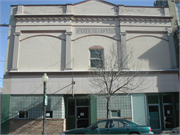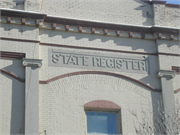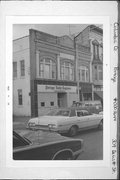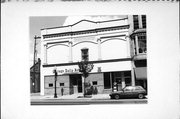Property Record
309 DEWITT ST
Architecture and History Inventory
| Historic Name: | STATE REGISTER |
|---|---|
| Other Name: | PORTAGE DAILY REGISTER |
| Contributing: | Yes |
| Reference Number: | 3644 |
| Location (Address): | 309 DEWITT ST |
|---|---|
| County: | Columbia |
| City: | Portage |
| Township/Village: | |
| Unincorporated Community: | |
| Town: | |
| Range: | |
| Direction: | |
| Section: | |
| Quarter Section: | |
| Quarter/Quarter Section: |
| Year Built: | 1909 |
|---|---|
| Additions: | |
| Survey Date: | 1992 |
| Historic Use: | small office building |
| Architectural Style: | Neoclassical/Beaux Arts |
| Structural System: | Brick |
| Wall Material: | Brick |
| Architect: | |
| Other Buildings On Site: | |
| Demolished?: | No |
| Demolished Date: |
| National/State Register Listing Name: | Portage Retail Historic District |
|---|---|
| National Register Listing Date: | 4/27/1995 |
| State Register Listing Date: | 10/24/1994 |
| National Register Multiple Property Name: |
| Additional Information: | Parapet with triangular pediment; string course with dentils; 4 Ionic pilasters between 3 elliptical arches in recessed area, first floor store front with two recessed entrance altered and 2 windows uneer arched close on 2nd floor. Edward Fink arrived in Portage in 1859 and established a bakery, restaurant, and confectionery in that year. From at least 1885 and probably well before that date, he operated his business in the building which preceded the current Register Building built in 1909 (309 DeWitt, 25/8). His bakery business closed by 1905-06 (Butterfield 1880: 897; Columbia Co. Treasurer 1863- [1907-10]; R.L. Polk & Co. 1905-06). In April, 1861, A.J. Turner purchased the Portage City Record and the Register Building which once stood near the northwest corner of Canal and DeWitt from Robert Wentworth and merged the paper with the Wisconsin State Journal established by S. S. Brannan in March, 1861. Published by Brannan and Turner and edited locally by Turner and Isreal Holmes, the Register presented its editorials from a Republican perspective. Holmes sold his interest in the pa[per in 1864. From about 1861 until 1880, the Wisconsin State Register was published on the second floor of the Pettibone Block at the northwest corner of DeWitt and Cook (Wisconsin State Register 1861 [11/2: 1]). In 1878, Brannan and Turner sold the Wisconsin State Register to John T. Clark and Benjamin F. Goodell who served as editor. In 1880, the Wisconsin State Register was published in the City Bank Block, the building 202 W. Cook replaced in 1929-1930 (57/8). S. S. Rockwood purchased Clark's interest in the paper in 1885. S. S. Rockwood and F.F. Goodell sa the editor, became wners of the Register in 1885. In addition to the weekly Register, they began printing the Portage Daily Register on the second floor and basement of 210 W. Cook *56/7) in 1886. The newspaper remained there through 1889 (Sanborn-Perris Map Co. 1889). In 1887, Rockwood incorporated the Register Printing Company and considerably enlarged the operation. To print the two newspapers and operate the new bank book and binding factory, the company added presses and type, equipment for folding, printin, and stamping, and other equipment. The company then employed 22 operators. In 1891, Maurice Goodman purchased an interest in the Register Printing Company. J.H. Waggoner purchased the two newspapers in 1892 and edited them until 1894 when he sold it to Maurice Goodman. By 1894, the paper's offices occupied the second floor of 101 W. Cook (25/23). The Wisconsin State Register and portage Daily Register remained under Goodman's management until Arthur A. Porter purchased them in 1908 and served as their editor. In February, 1908, Porter moved the offices of the paper to 309 DeWitt and com[pleted a new, two story brick building in August, 1908 (Portage Daily Register 1908 [2/20: 3/5]; 8/4: 3/1]). Offices then occupied the second floor and other businesses leased one side of the ground floor. The paper later expanded to occupy about three quarters of the ground floor. In 1877, Henry D. and W.E. Bath began the Portage Democrat, the only English paper written from a democratic perspective since the Badger State ceased publication in 1859. After Irving Bath operated the paper from 1878 to 1881, J.E. Jones took over its ownership and operation in 1881. He guided the newspaper until 1919 when it was consolidated with the Portage Daily Register. Between at least 1908 and 1917, Jones located the paper on both floors of 214 W. Cook (56/6). Printing rooms occupied the first and composing rooms occurred on the second. A.A. Porter had sold the Wisconsin State Register to P.E. Pinkerton in 1918, and he in turn sold it to John G. Cary in 1919. Cary purchased the weeklies and dailies of the Democrat from Jones. He combined the two dailies into the Register-Democrat and continued separate publication of the two weeklies as the Wisconsin State Register and the Portage Weekly Democrat. A.A. Porter again purchased the papers in 1920. In 1942, he sold them to the Comstock Publishing Company, and in July, 1954, Gladys Porter sold the building to the same company. Dropping the Democrat portion of the title, W.T. Comstock edited the Portage Daily Register after 1942. He ceased publication of the Weekly Wisconsin State Register in 1944. The building underwent major renovation in 1955 to 1956 when the plate glass front was filled with stone veneer and glass in 1955 to 1956 when the plate glass front was filled with stone veneer and glass block windows, and the company completed interior alterations to accommodate new equipment. In 1957, Max Lavine purchased the paper from the Comstock Publishing equipment. In 1957, Max Lavine purchased the paper from the Comstock Publishing Company, and John Lavine became publisher of the paper after his father's death in 1964 (Register-Democrat 4/3/1919; 3/1/1923; 3/15/1940; 10/4/1956; Portage Daily Register 12/23/89; 1942 [10/3: 1]; 7/2/1954; 11/9/1968; Jones 1914: [1] 133-37, 143; Portage Public Library n.d. [after 1964]; Wisconsin State Register 6/13/1874; 8/10/1914). In 1897, Moran and Arthur as the Cash Store represented a dry goods firm operated by Edward C. Moran with partner Miss Grace E. Arthur. The store occupied part of 309 DeWitt Street by 1908-1909. it included dry goods, dress good, underwear, hoisery, tin and granite ware, china, groceries, and sheet music (Democrat 7/30/97: 4: Voshardt 1910: 25; S.H. Moore 1908-09). Professional offices also occupied the Register building. Edmuind S. Baker practiced lawin Portage beween 1870 and 1927. In 1927, Ross Bennett continued Baker's legal practice which had been located over 134 W. Cook (47/12) between 1890 and 1918. Bennett served as county district attorney between 1929 and 1933. He formed a partnership with John Taras between 1931 and 1934. In 1956, he established the firm of Bennett and Bennett when David Bennett joined his law firm. By 1929, Bennett's offices occu[pied prat of the Register Building (309 DeWitt, 25/2). The Bennett law firm moved to 136 W. Cook (57/11) by 1`948 and remained there through 1955. It is now located at 139 W. Cook, (56/26). The law offices of David Bogue and Sanderson remained at 309 DeWitt between 1917 and 1929 (Columbia County Historical Society 1982; Smith-Baumann Directory Company 1929; Commonwealth Telephone Co. 1937; 1948; Johnson Printing Co. 1955). Additionally, the H.J. Heinz Company which located its plant in Portage in 1904 placed its office in the building ca. 1929 (Church 1970: 18; Columbia County Historical Society 1982; Sanborn-Perris Map Company 1910; 1918; 1929; WPA 1938: 52; Portage Daily Register 6/10/1972). |
|---|---|
| Bibliographic References: | PORTAGE 1989 LANDMARKS CALENDAR. Historic Portage, WI: Downtown & Waterfront Walking Tour, 1995. |
| Wisconsin Architecture and History Inventory, State Historic Preservation Office, Wisconsin Historical Society, Madison, Wisconsin |




